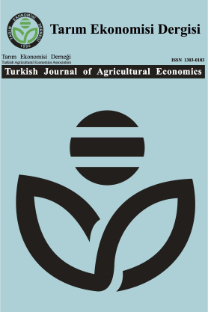Tarımsal Makineleşme Tarımsal Üretim üzerinde Ne Kadar Etkili? Bir Panel Veri Analizi
Makineleşme, Tarımsal Üretim, Sürdürülebilirlik, ARDL test
How Effective is Agricultural Mechanization on Agricultural Production? A Panel Data Analysis
Mechanization, Agricultural production, Sustainability, ARDL test,
___
- Akdemir, B. (2013). Agricultural Mechanization. IERI Procedia, 5: 41-44.
- Altuntas, E. (2016). Türkiye’nin Tarımsal Mekanizasyon Düzeyinin Coğrafik Bölgeler Açısından Değerlendirilmesi. Türk Tarım-Gıda Bilim ve Teknoloji Dergisi, 4(12): 1157-1164. https://doi.org./10.24925/turjaf.v4i12.1157-1164.972
- Bayrac, H. N. and Dogan, E. (2016). Türkiye’de İklim Değişikliğinin Tarım Sektörü Üzerine Etkileri. Eskişehir Osmangazi Üniversitesi İİBF Dergisi, 11(1): 23-48.
- Breusch. T. and Pagan, A. (1980). The Lagrange Multiplier Test and Its Applications to Model Specification in Econometrics. The Review of Economic Studies, 47(1): 239-253. https://doi.org/10.2307/2297111
- Chudik, A. and Pesaran, M. H. (2013). Common Correlated Effects Estimation of Heterogeneous Dynamic Panel Data Models with Weakly Exogenous Regressors. Federal Reserve Bank of Dallas Globalization and Monetary Policy Institute Working Paper No. 146. https://doi.org/ 10.1016/j.jeconom.2015.03.007
- Dinar, A., Campbell, M. B. and Zilberman, D. (1992). Adoption of Improved Irrigation and Drainage Reduction Technologies under Limiting Environmental Conditions. Environmental and Resource Economics, 2: 373-398. https://doi.org/10.1007/BF00304968.
- Dogan, M. (2005). Türkiye Ziraatinde Makineleşme: Traktör ve Biçerdöverin Etkileri. İstanbul Üniversitesi Edebiyat Fakültesi Coğrafya Bölümü Coğrafya Dergisi, 14: 66-75.
- Eryilmaz, T., Gokdogan, O. and Yesilyurt, M. K. (2014). Yozgat İlinin Tarımsal Mekanizasyon Durumunun İncelenmesi. Türk Tarım ve Doğa Bilimleri Dergisi, 1(2): 262–268.
- Feder, G., Just, R. E. and Zilberman, D. (1985). Adoption of Agricultural Innovations in Developing Countries, A Survey. Economic Development and Cultural Change, 33: 255-298. https://doi.org/ http://dx.doi.org/10.1086/451461
- Griliches, Z. (1957). Hybrid Corn: An Exploration in the Economics of Technological Change. Econometrica, 25: 501-522. https://doi.org/10.2307/1905380
- Hayaloglu, P. (2018). İklim Değişikliğinin Tarım Sektörü ve Ekonomik Büyüme Üzerindeki Etkileri. Gümüşhane Üniversitesi Sosyal Bilimler Enstitüsü Elektronik Dergisi, 9(25): 51-62.
- Kilavuz, E. and Erdem, I. (2019). Agriculture 4.0 Applications in the World and Transformation of Turkish Agriculture. Social Sciences, 14(4): 133-157. https://dx.doi.org/10.12739/NWSA.2019.14.4.3C0189
- Kocturk, B. and Avcioglu, A. (2007). Türkiye’de Bölgelere ve İllere Göre Tarımsal Mekanizasyon Düzeyinin Belirlenmesi. Tarım Makinaları Bilimi Dergisi, 3(1): 17-24.
- Lingard, J. and Bagyo, A. S. (1983). The Impact of Agricultural Mechanisation on Production and Employment in Rice Areas of West Java. Bulletin of Indonesian Economic Studies, 19(1): 53-67. https://doi.org/10.1080/00074918312331334299
- Onurbas, A. and Atasoy, Z. D. (2002). A Research on Agricultural Mechanization Level of Turkey. In: 5th International Conference on Agricultural and Forest Engineering, 19-20 June, Warsaw, pp. 497-503.
- Ozguven, M. M., Turker, U. and Beyaz, A. (2010). Türkiye’nin Tarımsal Yapısı ve Mekanizasyon Durumu. GOÜ Ziraat Fakültesi Dergisi, 28(2): 89-100.
- Pesaran, M. H. (2004). General Diagnostic Tests for Cross Section Dependence in Panels. IZA Discussion Paper 1240.
- Pesaran, M. H. (2007). A Simple Panel Unit Root Test in the Presence of Crosssection Dependence. Journal of Applied Econometrics, 22(2): 265–312. https://doi.org/10.1002/jae.951
- Rehman, A., Jingdong, L., Khatoon, R. and Hussain, I. (2016). Modern Agricultural Technology Adoption Its Importance Role and Usage for the Improvement of Agriculture. American-Eurasian Journal of Agricultural & Environmental Sciences, 16(2): 284-288. http://dx.doi.org/10.5829/idosi.aejaes.2016.16.2.12840
- Singh, G. (2006). Estimation of A Mechanisation Index and Its Impact on Production and Economic Factors-A Case Study in India. Biosystems Engineering, 93(1): 99-106. https://doi.org/ :10.1016/j.biosystemseng.2005.08.003
- Srisompun, O., Athipanyakul, T. and Somporn, I. (2019). The Adoption of Mechanization, Labor Productivity and Household Income: Evidence from Rice Production in Thailand. TVSEP Working Paper No. WP-016.
- Tandogan, N. S. and Gedikoglu, H. (2020). Socio-economic Dimensions of Adoption of Conservation Practices: What is Needed to be Done?, in Shaon Kumar Das (Eds.), Organic Agriculture, (pp. 1-21). https://doi.org/ 10.5772/intechopen.93198
- TUIK. (2021a). İstihdam Edilenlerin Yıllara Göre İktisadi Faaliyet Kolları ve Dağılımı. Retrieved in May, 15, 2021 from https://data.tuik.gov.tr/Kategori/GetKategori?p=istihdam-issizlik-ve-ucret-108&dil=1.
- TUIK. (2021b). Tarımsal Alet ve Makineler. Retrieved in May, 10, 2021 from https://biruni.tuik.gov.tr/bolgeselistatistik/tabloYilSutunGetir.do?durum=acKapa&menuNo=191&altMenuGoster=1.
- TUIK. (2021c). Tahıllar ve Diğer Bitkisel Ürünlerin Üretim Miktarı. Retrieved in May, 9, 2021 from https://biruni.tuik.gov.tr/bolgeselistatistik/tabloYilSutunGetir.do?durum=acKapa&menuNo=191&altMenuGoster=1.
- Westerlund, J. (2008). Panel Cointegration Tests of the Fisher Effect. Journal of Applied Econometrics, 23: 193-223. https://doi.org/10.1002/jae.967
- Wilson, P. N. (2001). First-order Economizing: Irrigation Technology Adoption and the Farm. Agrekon, 40(2): 231-248. https://doi.org/10.1080/03031853.2001.9524947
- Yurtlu, Y. B., Demiryürek, K., Bozoğlu, M. and Ceyhan, V. (2012). The Risk Perception of the Farmers on Agricultural Machinery Using. Ege Üniversitesi Ziraat Fakültesi Dergisi, 49(1): 93-101.
- Zilberman, D., Khanna, M. and Lipper, L. (1997). Economics of New Technologies for Sustainable Agriculture. Australian Journal of Agricultural and Resource Economics, 41(1): 63-80. https://doi.org/ 10.22004/ag.econ.118008
- ISSN: 1303-0183
- Yayın Aralığı: Yılda 2 Sayı
- Başlangıç: 1992
- Yayıncı: Tarım Ekonomisi Dergisi
Gıda İsrafının Belirleyicileri: Sosyoekonomik Değişkenler Açısından Bir Değerlendirme
Tarımsal Makineleşme Tarımsal Üretim üzerinde Ne Kadar Etkili? Bir Panel Veri Analizi
Uluslararası fındık ticaretinin gelişimi ve ihracat etkisinin belirleyicileri
Semanur SOYYİĞİT, Kiymet YAVUZASLAN
Zerrin ÇELİK, Şener ÖZÇELİK, Zübeyde ALBAYRAM DOĞAN, Başak AYDIN
İktisatın Unutulmuş Çocuğu: Tarım Sektörü ve Tarımın Orta Doğu’daki Geleceği
Çukurova Bölgesi’nde Gıda Sanayinde Dış Ticaret Teşviklerinin Değerlendirilmesi
Nurçin ÇINAR, Sait ENGİNDENİZ, Gökhan ÇINAR
Türkiye’de Sera Çiftçilerinin Pestisit Kullanımı ve Risk Algılamaları: Mersin İli Örneği
Seyit HAYRAN, Ahmet Duran ÇELİK, Aykut GÜL
Türkiye’de Uygulanan Tarımsal Destekleme Politikalarının Ayçiçeği Üretimine Etkisinin Analizi
